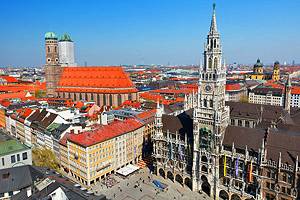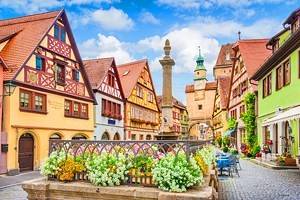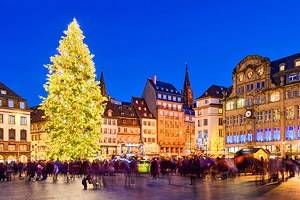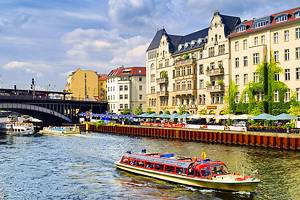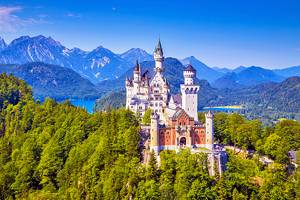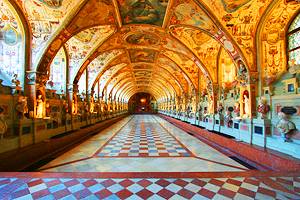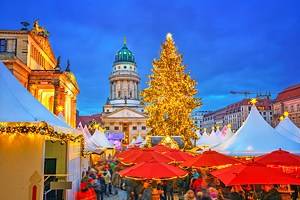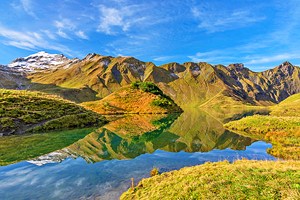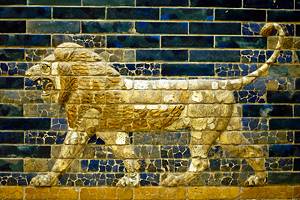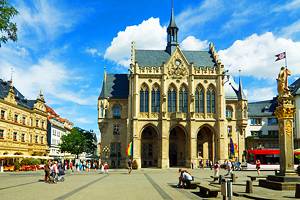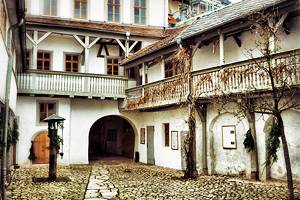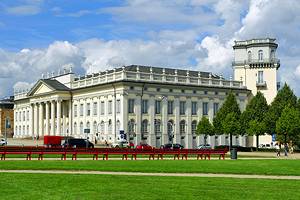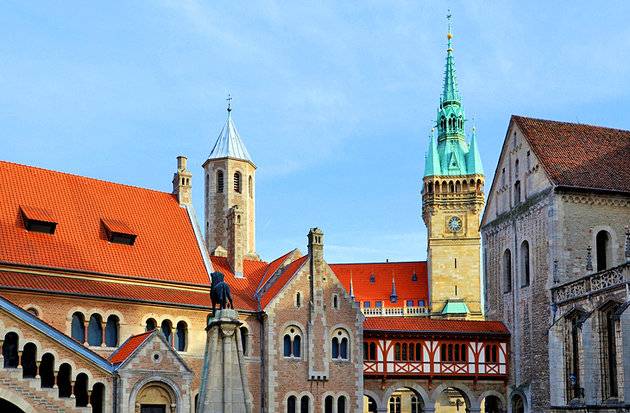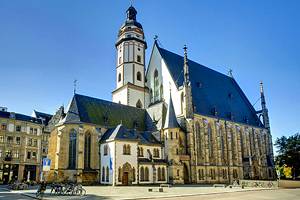Castles in Germany
With as many as 20,000 castles in Germany, tourists have plenty to choose from. These range from the poster child of castles everywhere – Nueschwanstein – to little-known ruins of medieval fortresses, and are so plentiful that this list can only spotlight a small fraction of them.
Of necessity, many beautiful and fascinating castles have been left out: beautiful in-town castle/palaces like Dresden Royal Castle; smaller manor-house castles like waterside Mespelbrunn; Torgau's Early Renaissance Castle Hartenfels, where Martin Luther preached; or Burghausen, reputed to be the largest castle in the world.
Instead, we have chosen those that represent the epitome of castledom, castles that inspired the Grimm Brothers, those whose turrets, towers, and drawbridges will make you feel as though you've stepped back centuries – or into a fairy tale. These have been chosen as the best places to visit for their visual impact, historical significance, variety, and tourist experience. Plan your family's travels guided by this list of the best castles in Germany.
Nueschwanstein
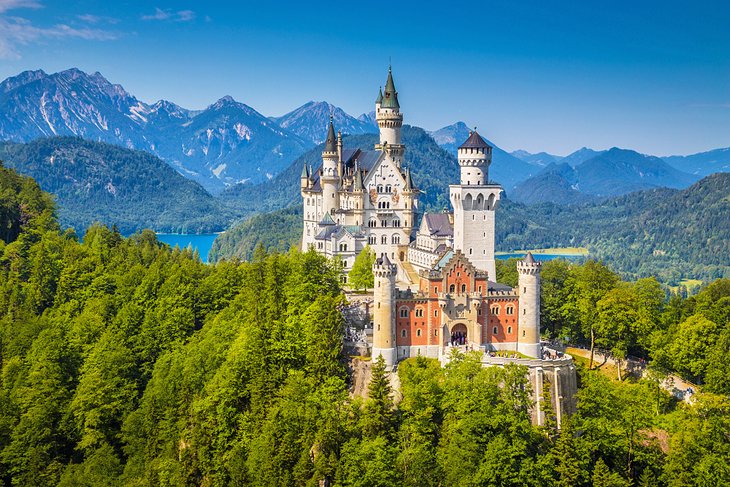
Conceived in the mind of "Mad" King Ludwig of Bavaria as a fantasy retreat from the world, Nueschwanstein incorporates myth, Romantic literature, grand opera, and Teutonic chivalry in its architectural and decorative palette. The result is a cross between neo-Romanesque and neo-Gothic mixed with fairy tale, an exuberant concoction of spires, turrets, battlements, and pitched roofs set atop a rocky crag surrounded by forest.
As though a painted backdrop for this stage set, a jagged line of Alpine foothills rises behind the castle and forms breathtaking views that are framed by its windows. Only 15 of the 200 rooms planned for the castle were completed before Ludwig's death in 1886, but "rooms" hardly conveys the size or grandeur of the finished halls. The Throne Room, the Singers' Hall, Ludwig's bedroom, and other grandiose rooms are decorated in murals, mosaics, arcades and carved oak.
So popular is this tourist attraction that you need to reserve a visit several days in advance.
Address: Neuschwansteinstraße 20, Schwangau
Official site: www.neuschwanstein.de/englisch/tourist/index.htm
Hohenzollern Castle (Burg Hohenzollern)
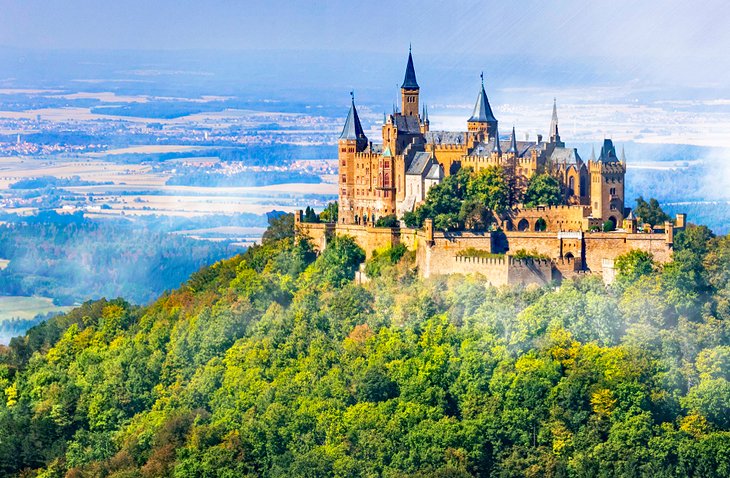
The third castle to stand on top of this mountain in Baden-Württemberg, Hohenzollern Castle is the ancestral home of the imperial family of Germany, the House of Hohenzollern. Their monarchy ended with the abdication of Kaiser Wilhelm II at the end of World War I, and many of the dynasty's royal artifacts are displayed here, including the Prussian royal crown and items belonging to Frederick the Great.
The original castle was built in the early 1200s but was destroyed in 1423. A bigger and more fortified replacement was built in 1454 but had fallen to ruin by the beginning of the 19th century.
In 1850, King Frederick William IV built the current neo-Gothic fortified complex, considered a masterpiece of 19th-century military architecture. The sumptuous palace sits inside a walled fortress, entered through an impressive gate.
The castle is still owned and occupied by the Hohenzollerns and is open to tourists year-round. Guided tours through show- and staterooms include glimpses into the family history, as well as royal treasures and gold and silver work, paintings, and royal robes. One of the top Christmas markets in Germany is held here on two weekends in early December.
Official site: https://www.burg-hohenzollern.com
Schwerin Castle (Schweriner Schloss)
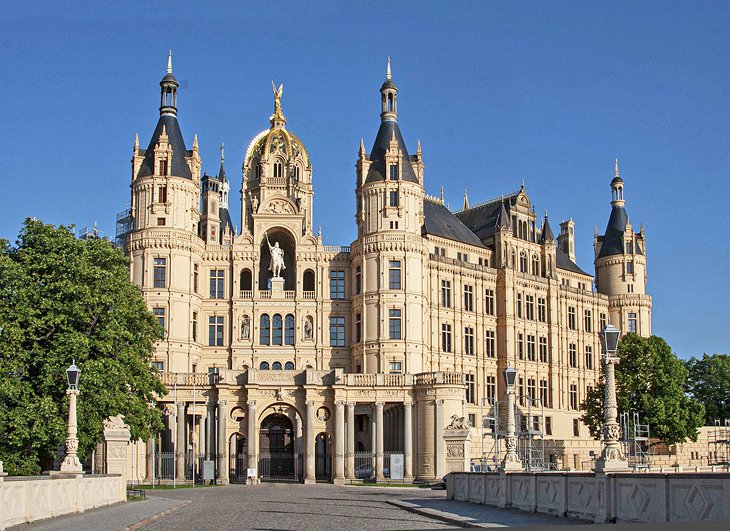
Unlike many other castles, which sit atop steep hills or perch on rocky crags for defense, Schwerin Castle is almost entirely surrounded by water. Only a bridge connects it to Schwerin, the capital of Mecklenburg-Vorpommern in northern Germany.
Its onion-domed cupolas, tea caddy tower, and pointed spires mark it as an example of Romantic Historicism, and it joins Nueschwanstein as one of Germany's prime examples of the style. In fact, it is sometimes nicknamed "Nueschwanstein of the North."
Its origins go as far back as 973, and a castle has stood on the islands ever since, becoming the seat of the Dukes of Mecklenberg. In late Gothic times, the dukes changed the fortress into a palace more representative of their increasing wealth and power, replacing some of the defenses with more ornamental additions; in the mid-1500s, bastions were added that are still standing today.
In the mid-1800s, Grand Duke Friedrich Franz II ordered a complete reconstruction that retained only parts of the 16th- and 17th-century building. The results were the current somewhat fanciful castle/palace, which underwent a massive preservation following the reunification of Germany. The opulent interior gleams once again; the highlight is the magnificent Throne Room.
Address: Lennéstraße 1, Schwerin
Heidelberg Castle (Heidelberger Schloss)
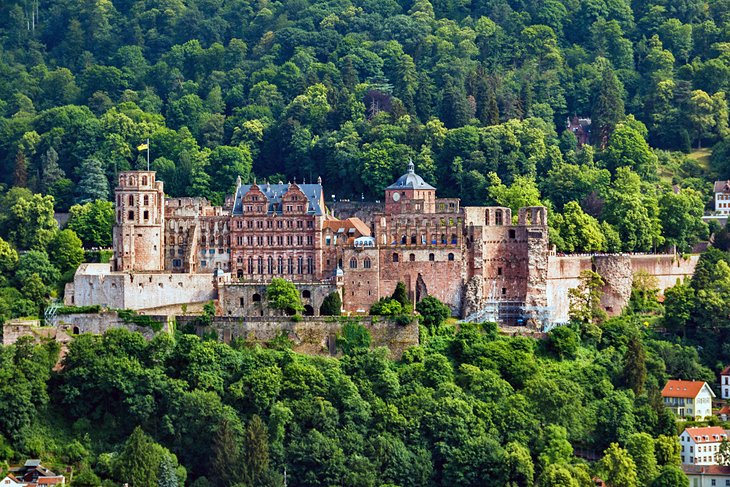
The massive red sandstone Heidelberg Castle is one of the best surviving examples of German Renaissance architecture. It stands in a commanding position on the hillside directly above the Old Town in Heidelberg, almost 200 meters below, forming a backdrop visible from almost any point in town or along the Neckar River.
Its origins are around 1300, and a century later Prince Elector Ruprecht III made it the regal residence, which it remained until it was burned by the French in 1689 and again in 1693. A third fire, started by lightning in 1764, left it uninhabitable but the most picturesque – and largest – castle ruin in Germany.
You can visit the interior on regular tours to see the castle courtyard, a pharmacy museum, and the cellar, where there's a giant barrel seven meters high. Concerts, performances, and festivals are held in the courtyard, and three times each summer there are huge fireworks displays.
You can get to Heidelberg Castle on the Bergbahn, a funicular railway running from the Kornmarkt, or via a 15-minute walk from the Old Town. A round-trip ride on the funicular is included in the castle tour ticket.
Address: Schlosshof 1, Heidelberg
Official site: www.schloss-heidelberg.de/en/home/
- Read More: Attractions in Heidelberg & Easy Day Trips
Wartburg Castle (Schloss Wartburg)

Hailed in its UNESCO World Heritage Site citation as "an outstanding monument of the feudal period in central Europe," Wartburg Castle is also important as the place where Martin Luther translated the New Testament into German. The importance of that work extends far beyond its religious significance: the translation marked the beginning of a unified and accessible written German language.
Wartburg Castle was originally built in the second half of the 12th century and still preserves some original sections from its feudal period, but much is a well-researched 19th-century reconstruction. The result is that you see it as it would have looked at its height of power and importance in the Middle Ages. That importance is emphasized by its position atop a 400-meter elevation.
Enter through a medieval drawbridge to find a courtyard surrounded by half-timbered buildings and battlemented parapets. Beautifully restored halls and rooms recreate the life here in medieval and Renaissance eras. Period furnishings and other displays draw on the castle's collections of over 9,000 historic items, and the art collections include works by the painter Lucas Cranach the Elder.
Address: Auf der Wartburg 1, Eisenach
Official site: https://www.wartburg.de
Marburg Castle (Landgrafenschloss)
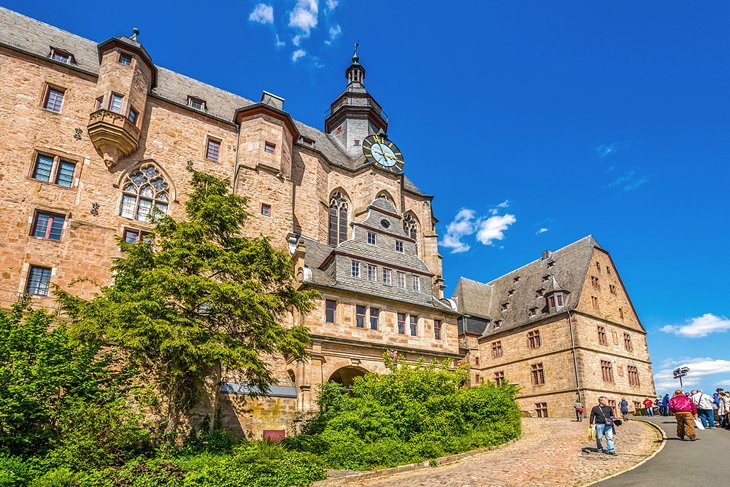
The impressive castle that sits above the charming town of Marburg has its origins as early as AD 1000 and is one of Germany's earliest hillforts. The castle that crowns the town today dates from the 13th century and was a principal residence of the Landgraves of Hesse until 1604.
Many visitors come to Marburg as part of the German Fairy Tale Route; the brothers Jacob and Wilhelm Grimm studied at the university here, and the castle inspired some of their stories. Today, the well-preserved castle houses the impressive Museum of Art and Cultural History, whose exhibits fill five floors.
In the basement of the west wing, you can see old fortifications from the 9th and 10th century. The museum portions of the castle are open year-round, and there are walking tours through the castle and its casements on weekends from April through October.
Address: Schloss 1, Marburg, Hess
Nuremberg Castle (Nürnberger Burg)
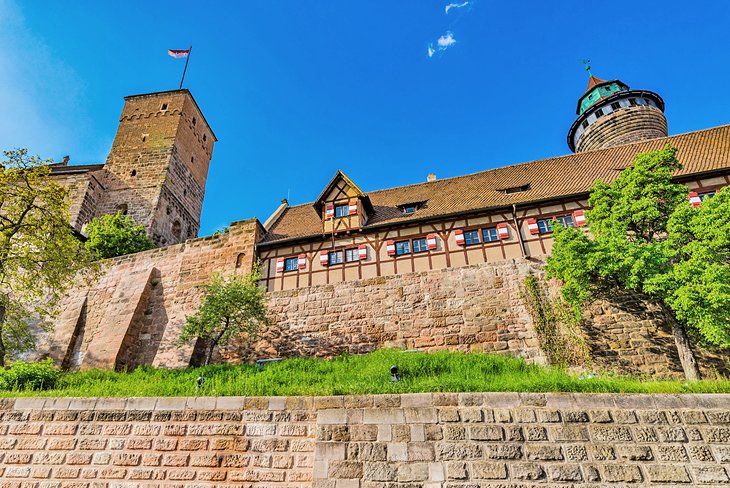
The Old Town of Nuremberg is dominated by its castle, a fortification that's among the most important surviving medieval fortresses in Europe. Home of German kings and emperors for more than 500 years, Nürnberger Burg – despite serious damage in World war II and post-war reconstruction – still looks much as it has through the centuries. First mentioned as a royal property in 1050, it became a major scene of royal activity and Imperial Diets throughout the time of the Holy Roman Empire and later monarchies.
There is a lot to see in the castle; the oldest parts are the Pentagonal Tower and the Kaiserburg, both dating from the 11th century. The chapel is from the 13th century, as is the Sinwell Tower, and the famous Deep Well dates at least from that time.
A highlight of a castle tour is the dramatic demonstration of the well's depth, reaching more than 50 meters into the rock below. Exhibits in the Imperial Castle Museum illustrate the history of the castle and display medieval weapons and armor.
Address: Auf der Burg 13, Nürnberg
Official site: www.kaiserburg-nuernberg.de/englisch/castle/index.htm
Wernigerode Castle (Schloss Wernigerode)
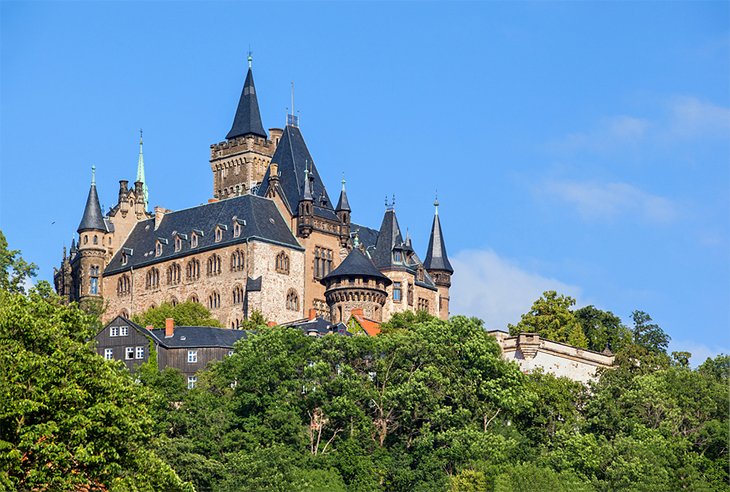
Built in the Middle Ages as a secure stopping place for emperors and their entourages on hunting trips to the Hartz Mountains and subsequently expanded in the late Gothic style, Wernigerode Castle was transformed into a Renaissance fortress in the 16th century.
Badly damaged in the Thirty Years War, it was rebuilt in the Baroque style as a residence for a local count. His descendants further modified it in the 19th century in the Romantic style known as North German Historic, which is what you'll see today.
You'll see remains of most of these styles – a Renaissance staircase tower, Gothic arched windows in the courtyard – as you explore. In its nearly 50 rooms, many lavishly decorated with inlaid floors, paneled walls, and marble fireplaces, are changing exhibits on castle life in its various eras. The castle is surrounded by a park and terraced gardens, and you can reach its lofty setting on foot, by a tourist train, or in a horse-drawn wagon.
Address: Am Schloß 1, Wernigerode
Marksburg Castle (Schloss Marksburg)
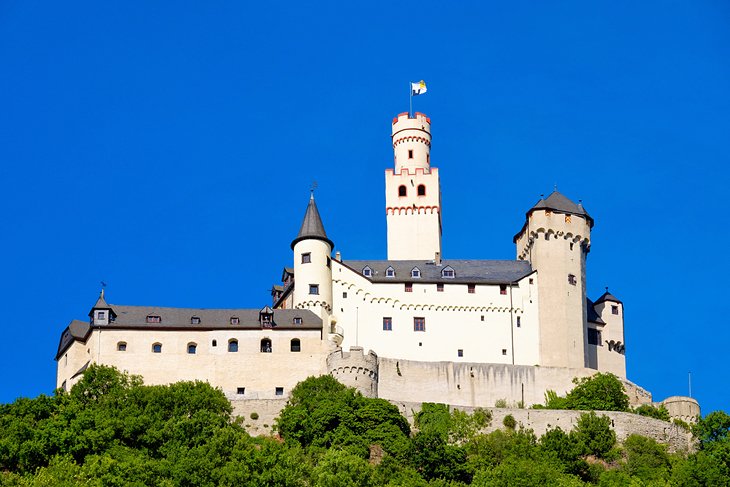
One of the principal landmarks of the Upper Middle Rhine Valley UNESCO World Heritage Site, Marksburg is the only one of the 40 hill castles in this stretch of the river that has never been destroyed or fallen into disrepair.
First mentioned in 1231, the Romanesque castle was built high above the river, with a triangular layout that it retains today. Its builders were one of the most powerful families of the time, as were the next owners, who built the Gothic parts of the castle that give it much of its present-day appearance. When Marksburg passed to the Landgraves of Hesse in 1479, they turned it into a fortress, adding ramparts and batteries.
After entering through a drawbridge gate, visitors come to a second medieval gateway, then a third before reaching to Riders Stairway, a winding series of steps carved from the bedrock in a shallow series that could be ascended on horseback.
From here, you can explore the batteries, the medieval cellars, an herb garden, the kitchen, Great Hall, a bedroom, and a 14th-century chapel with painted walls and ceilings. Climb the tower for sweeping views across the Rhine.
Official site: https://www.marksburg.de/en/
Eltz Castle (Burg Eltz)
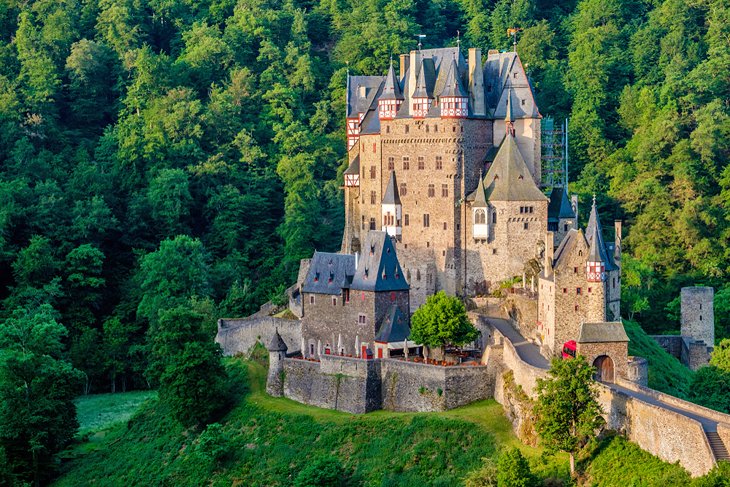
Like Hohenzollern Castle in Southwest Germany, Burg Eltz will more than satisfy your kids' desire to see a real fairy tale castle. It not only looks the part with its towers and access over a narrow bridge, but the setting is perfect, too, atop a 70-meter-high rock outcrop surrounded by dense forest. Soaring stone walls and towers, pointed turrets, sharply pitched roofs, and red half-timbering make Burg Eltz an unforgettable sight against the forested hillside.
The castle is owned by the Kempenich family, as it has been since is origins in the 12th century, and has been carefully maintained and restored, with striking interiors and much of its original furnishings. It is one of Germany's best examples of a medieval castle.
Enlarged over the centuries, by the mid-1600s, the castle had reached its present size, with eight tall residential buildings totaling 100 rooms, around the central courtyard. Careful restoration in the 19th century did not alter the structures or their decoration.
The Knights Hall, with its suits of armor and an original 15th-century kitchen, are highlights of a tour, as are the armory and treasury. These house one of Germany's most important private collections of historic art works, including gold and silver, jewelry, glass, porcelain, ivory, weapons, and curiosities – more than 500 objects.
Address: Eltz Castle, Burg-Eltz-Strasse 1, Wierschem
Official site: https://www.burg-eltz.de/en/
Weesenstein Castle (Schloss Weesenstein)
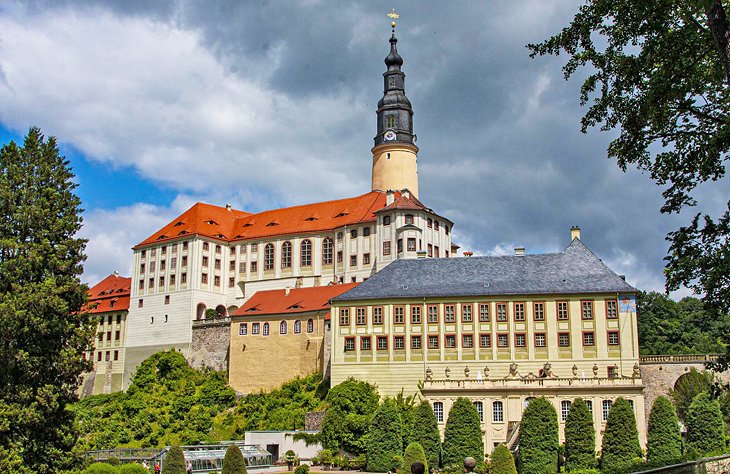
From the town below, visitors don't realize the vast size of Weesenstein Castle; it's really three castles in one, each built at a different time and in an order that makes the arrangement seem upside down. Because the earliest castle, a military fortification first mentioned in 1318, was built at the highest defensive position, subsequent additions descended the hill in succession until the final construction of a princely residence at the bottom, in the 18th and 19th centuries.
The result seems topsy-turvy: the stables are on the fifth floor, and the vaulted cellars below them are above the grand residential rooms and chapel. As you travel upwards from the 19th century to the Middle Ages, exhibits in each part illustrate life in that era. The lower – and later –rooms are fully furnished as they were when in use by the King of Saxony in the 1800s, with the original furniture, decor, and historical tapestries.
Below the castle stretches a park with lovely formal gardens highlighted by a rose garden; fountains; a tea house; and the river Müglitz, which flows through it.
Address: Am Schloßberg 1, Müglitztal
Official site: https://www.schloss-weesenstein.de/en
Hohenschwangau
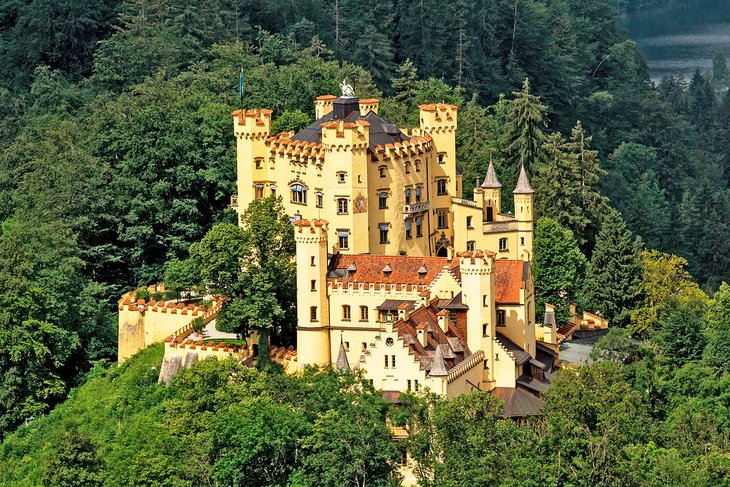
An original 12th-century castle was already in ruin when it was rebuilt in the mid-1500s, then was again left in partial ruin by Austrian troops in 1743. Almost 100 years after that, the Bavarian Crown Prince, later King Maximilian II, father of King Ludwig II, bought the castle and began rebuilding according to the original plans.
Inside the neogothic exterior of crenelated towers, the halls and chambers were covered in almost 100 murals and paintings of local historic events and German heroic legends of Parsival, Lohengren, and other romantic sagas. Queen Marie created an alpine garden surrounded by a castellated wall and it, too, was filled with symbols of the romantic stories, including a fountain in the shape of a water-spouting swan.
Hohenschwangau became the royal summer residence, and young Ludwig grew up in the surroundings infused with romantic legends of chivalry and knighthood. He lived here after his father's death, when he became king, and until the completion of his own fantastical Neuschwanstein castle atop a facing crag.
A tour of the castle is like stepping into the Romantic Era, with grand halls and chambers filled with original 19th-century Biedermeier furnishings surrounded by scenes from legends. It's easy to see where Ludwig got his own fascination for the romantic tales that shaped his vision for his own castle, Neuschwanstein.
Address: Alpseestraße 30, Schwangau
Burg Schönfels
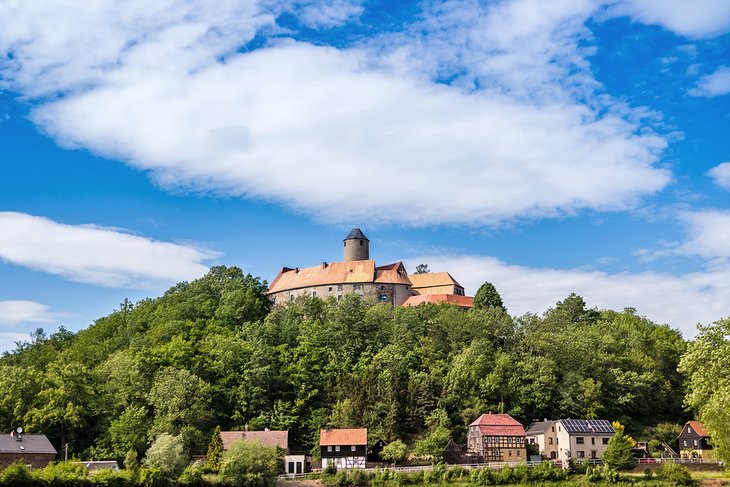
Rising on a wooded hilltop above a small half-timbered village near Zwickau, Burg Schönfels began about 1200, to help stabilize new settlements in the borderlands under Emperor Friedrich I. With its moat, ramparts, and closed complex of original buildings, Schoenfels is one of the best-preserved fortified castles in all Germany.
The castle was last "modernized" in the 15th and 16th centuries, under the ownership of the Lords of Weissenbach, and it retains that appearance today, giving a good picture of how its residents lived. Recent archaeological work has turned up more glimpses into the castle's history, and a small exhibit demonstrates some of the techniques used in the research.
The castle's chapel retains a beautifully decorated Baroque pulpit, a Gothic altar, and an organ with wooden pipes. You can climb the tower for views of the village and countryside.
Address: Burgstraße 34, Lichtentann, Saxony
Reichsburg Castle

In the 12th century, Reichsburg Castle collected tolls from ships carrying cargo on the Mosel between the former Roman town of Trier and the Rhine River. Although the castle stood at a commanding 330 meters above the river, ships were stopped by a removable chain across the river.
The castle was expanded several times as the tolls filled the pockets of the bishops and electors of Trier, who controlled it from the 14th to the 16th century. In 1689, the French, under King Louis XIV, invaded the region and blew up the castle, leaving it and Cochem in ruin. And so it stayed until a Berlin businessman bought it and began construction in 1868.
While he incorporated the remains of the Gothic castle, including its central tower, the castle he built was neo-Gothic. Like Neuschwanstein, which was under construction at the same time, it is a fine example of how the enthusiasm of the 19th-century Romantic era built a neo-Gothic fantasy from the crumbling ruins of a medieval castle.
Reichsburg Castle has a variety of tours, some of which include a feast with minstrels. At the beginning of August, a Medieval Festival includes a market of crafts and foods, with troubadours and performers playing period instruments.
Address: Schloßstrasse 36, Cochem
Official site: https://reichsburg-cochem.de/the-castle/?lang=en
Lichtenstein Castle (Schloss Lichtenstein)
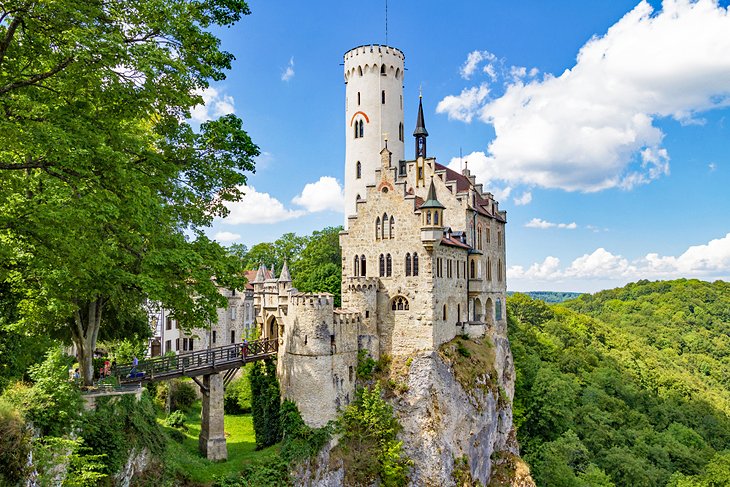
Sitting on a high rocky outcrop at the edge of the Swabian Alps and reached by a narrow wooden bridge, Lichtenstein Castle is not all it appears to be. Although this crag has been the site of several earlier castles, the neo-Gothic one built on their foundations is an 1800s version of a medieval castle. The elevation accentuates its steep walls and tall round tower, and the narrow access bridge over a ravine completes its story-book charm.
Rooms inside Lichtenstein Castle are opulently decorated in the Romantic style, with elaborate painted ceilings and carved wooden details; highlights are the colorful wall paintings, 15th- and 16th-century glass painting in the chapel, and the Knights' Hall. Lichtenstein Castle is an hour from Stuttgart.
Address: Schloss Lichtenstein 1, Lichtenstein
Official site: https://www.schloss-lichtenstein.de/en/
More Related Articles on PlanetWare.com

Discovering More of Germany: For a good overview of the country's best experiences, see our articles on the tourist attractions in Germany and best places to visit in Germany. These are wonderful guides to help you plan where to go and what to see.
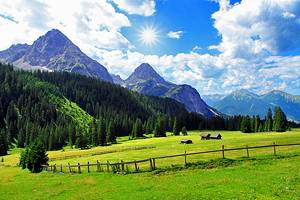
Exploring Germany's Most Popular Regions: Plan your travels through Germany's southeast with our pages on the tourist attractions in Bavaria and the top day trips from Munich. You'll find more about Southwest Germany described in our article on the tourist attractions in the Black Forest.



